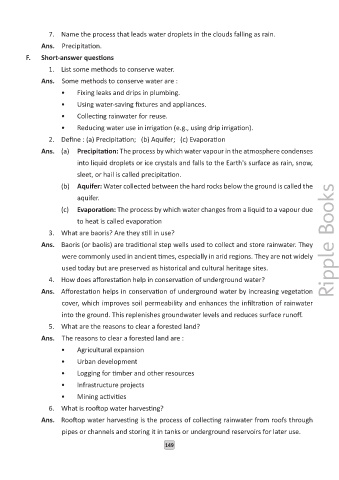Page 149 - Ripples SCIENCE 7 - TEJPUR Edition 2024 Answer Key
P. 149
7. Name the process that leads water droplets in the clouds falling as rain.
Ans. Precipitation.
F. Short-answer questions
1. List some methods to conserve water.
Ans. Some methods to conserve water are :
• Fixing leaks and drips in plumbing.
• Using water-saving fixtures and appliances.
• Collecting rainwater for reuse.
• Reducing water use in irrigation (e.g., using drip irrigation).
2. Define : (a) Precipitation; (b) Aquifer; (c) Evaporation
Ans. (a) Precipitation: The process by which water vapour in the atmosphere condenses
into liquid droplets or ice crystals and falls to the Earth's surface as rain, snow,
sleet, or hail is called precipitation.
(b) Aquifer: Water collected between the hard rocks below the ground is called the
aquifer.
(c) Evaporation: The process by which water changes from a liquid to a vapour due
to heat is called evaporation
3. What are baoris? Are they still in use?
Ans. Baoris (or baolis) are traditional step wells used to collect and store rainwater. They
were commonly used in ancient times, especially in arid regions. They are not widely
used today but are preserved as historical and cultural heritage sites.
4. How does afforestation help in conservation of underground water?
Ans. Afforestation helps in conservation of underground water by increasing vegetation
cover, which improves soil permeability and enhances the infiltration of rainwater
into the ground. This replenishes groundwater levels and reduces surface runoff.
5. What are the reasons to clear a forested land?
Ans. The reasons to clear a forested land are :
• Agricultural expansion
• Urban development
• Logging for timber and other resources
• Infrastructure projects
• Mining activities
6. What is rooftop water harvesting?
Ans. Rooftop water harvesting is the process of collecting rainwater from roofs through
pipes or channels and storing it in tanks or underground reservoirs for later use.
149

